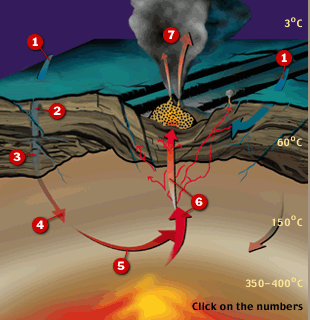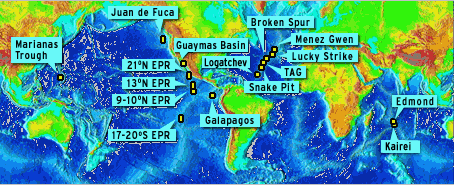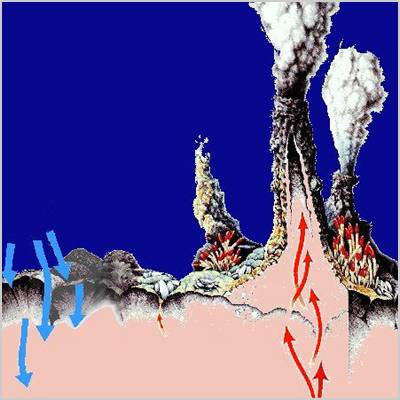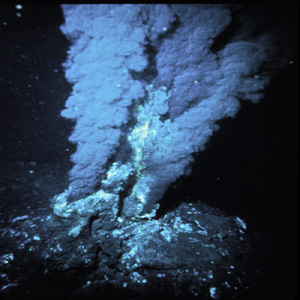
Introduction to Vent Geology
How do vents form?
Quickjump to:
What are Plate Tectonics?
What type of Geologic Activity occurs in the Oceans?
How does all this Geology relate to Hydrothermal Fields and Vents?
Then, what kind of Characteristics do Hydrothermal Fields have?
To fully understand the nature of the undersea environment, it is necessary to describe the mechanism that leads to the creation of it. This mechanism is known as plate tectonics.
Imagine the Earth as a giant baseball spinning around the sun. Remember that the exterior of a baseball is made up of several pieces of leather sewn together. Now, also imagine that these strips of leather are not stationary, but constantly changing. Some disappear while others appear. Some expand while others shrink. This simple illustration helps to simplify the theory of plate tectonics.
The earth, in general, is a very hot and active planet. The deeper one goes in the direction of earth's center, the hotter it gets. The only "cool" regions of the planet are found on the exterior of the earth. This hardened, yet dynamic exterior is the surface that we live on. Hardened because the ground is pretty solid when you walk on it. And yet dynamic because the hardened land still moves, changes shape, appears, and disappears. In the previous paragraph, the surface was compared to giant strips of leather on a baseball. These giant strips of leather represent the various tectonic plates that make up the earth's surface. If all the world's features, especially the oceans, were removed from the surface, this plate-like pattern would be readily seen. There is also a link to National Geographic which allows you to explore the undersea land formations in detail.
As was described in the example, these plates move relative to one another. Sometimes these plates rub. Other times, they drift apart. In any situation, though, these plates are far from being stationary.The Edmond vent system is located near the triple juction between the Austrailian Plate, the Antarctic Plate, and the African Plate. However, it is specifically located on the spreading region between the African Plate and the Austrailian Plate on the Central Indian Ridge
 Plates
move as a result of convection currents generated deep in earth's mantle
where
liquid forms of matter dominate over solid forms. This is due to the
higher
temperatures found deeper in the earth as compared to the temperatures on
the
surface. Convection currents are generated in regions where there are
differences
in temperature. Since outer regions of the planet are cooler than inner
regions.
Heated matter tends to flow into these colder regions while colder matter
flows
into the warmer regions. This sets up a circular exchange of matter. The
fluid-like
nature of land at high temperatures (even when they are cooled a certain
amount)
facilitates this circulation of matter. A single circular current is
called
a cell. Several cells around the world are responsible for the movement of
tectonic
plates. As tectonic plates move away from one another, lave bubbles out of
the
cracks and plates out on the ocean floor creating new land.
Plates
move as a result of convection currents generated deep in earth's mantle
where
liquid forms of matter dominate over solid forms. This is due to the
higher
temperatures found deeper in the earth as compared to the temperatures on
the
surface. Convection currents are generated in regions where there are
differences
in temperature. Since outer regions of the planet are cooler than inner
regions.
Heated matter tends to flow into these colder regions while colder matter
flows
into the warmer regions. This sets up a circular exchange of matter. The
fluid-like
nature of land at high temperatures (even when they are cooled a certain
amount)
facilitates this circulation of matter. A single circular current is
called
a cell. Several cells around the world are responsible for the movement of
tectonic
plates. As tectonic plates move away from one another, lave bubbles out of
the
cracks and plates out on the ocean floor creating new land.
What type of geological activity occurs in the world's oceans?
top
Since the surface of the earth is composed of several non-stationary tectonic plates, one would expect that there is plate movement both above and below the world's oceans. Geological activity found at the edges of these plates (areas where plates touch each other) is a result of these plate interactions and is necessarily found in both terrestrial and aquatic environments. This means that there are striking parallels between the surface world and the undersea universe. For example, as on land, there are canyons as well as mountain ranges on the ocean floor. There are volcanoes on the seafloor. Although volcanoes are a fantastic sight above ground, more than 75% of the volcanism on this planet happens in the deep oceans along the edges of these moving plates.
Plates that have land protruding above sea level are labeled continental plates. Most above sea level land is located on continents. The seven continents on our planet are North America, South America, Europe, Asia, Australia, Africa, and Antarctica. Other exceptions include the Indian subcontinent that moves on its own distinct plate, but is still considered part of Asia. Except in the case of small islands, most land is concentrated on the continents. For example, the islands of Hawaii are located in the center of the Pacific plate and are thousands of miles away from the nearest continent. Other examples are the Indonesian islands and the Polynesian islands. But islands are an indication of pervasiveness of geological activity around the world, particularly in our world's oceans.

As mentioned before, geological activity involving the disappearance and appearance of plates is concentrated near the boundaries of these plates in the form of ridges. Spreading and disappearance rates at these ridges can vary significantly. Almost 50% of the presently active ridges are slow spreading. This includes the Mid-Atlantic ridge as well as the Indian ridges. The Edmond Vent System, located on the Central Indian Ridge, has a rate of about 54 mm/a near the triple junction and 30mm/a near the equator. The East Pacific Rise is presently the only fast/super fast spreading center. Spreading centers are found all over the world.
Of course, this type of activity necessarily involves the release of heat. New land can only form with the eruption of new material, which is in itself, very hot. When volcanoes erupt, they spew forth magma, create new land, and heat up the surroundings in the process. The same situation occurs in the deep oceans. At depths exceeding 3000 meters, this thermal activity leads to temperature variances and creates a unique microclimate in an inhospitable environment. Most important though, these processes lead to the creation of hydrothermal fields.
How does all this Geology relate to Hydrothermal Fields and Vents?
top
Hydrothermal fields are areas near spreading centers where one can find an abundance of hydrothermal vents, otherwise known as sulfide mounds. Well, this begs the question: what is a hydrothermal vent? A hydrothermal vent is a structure that results from the exit of heated fluids from the crust into the ocean. These heated fluids are a result of seawater reacting with the newly formed crust deep in the seafloor.
Remember that seawater is not pure and that it's composition is highly variable. And also remember that the newly formed land that plates out on the seafloor also has variable composition. When water penetrates the seafloor and travels deep into the newly formed land into regions that have temperatures ranging between 400 and 700=B0C, it reacts with the rock and exchanges chemicals, thereby changing its composition. Fore more details about the chemistry of hydrothermal fluids go to Vent Chemistry. The seawater also separates into different phases due to an input of gas and the excessively high temperatures near the magma. Because of this activity, the new fluid mixture ascends to the ocean floor and is ejected. Thus, the same convective process that moves the earth's tectonic plates also applies to the situation of hydrothermal fluid. Hydrothermal fluids are a result of the circulation of seawater in the newly formed crust and the reactions between it and the rock.

This vented fluid is called hydrothermal fluid. The exact chemical composition of hydrothermal fluid is dependent upon the chemical composition of the newly formed land in a particular region as well as the composition of the seawater above it. As was mentioned, the area on the surface where these fluids are ejected is called a hydrothermal vent. The vent is, in itself, a unique consequence of the interaction between hydrothermal fluids and seawater. The vent is created by the precipitation of certain chemicals in the vent fluid. Vents can take on several different shapes patterned after their style of venting, and can reach heights of 45 meters high. One example of a very tall vent is "Godzilla" of the Juan de Fuca Ridge pictured on the right. In general, though, vent fluids form the foundation for the ecosystem found at these hydrothermal fluids.
Then, what kind of Characteristics do Hydrothermal Fields have?
topTemperatures prevalent at hydrothermal vents are around 3 to 4=B0C, and this is only about one to two degrees above the regular temperatures found elsewhere on the seafloor. Most of this temperature difference is a result of diffuse heating from spreading centers and to a lesser extent from the hydrothermal fluids. Heating as a result of hydrothermal fields accounts for less than 25% of the total temperature variance. Temperatures outside of the spreading center region drops almost immediately to 2=B0C. However, vent fluid temperatures are significantly different from the overall temperature of a hydrothermal field. The temperature range of hydrothermal vent fluids can be divided into two general categories based upon the type of fluid that the vent ejects.
Vent fluids coming from places termed "black smokers" tend to be much higher in temperature and range between 325 and 400=B0C while those of from "white smokers" range between 250 and 325=B0C. These names are tagged on to these hydrothermal vents because of the nature of the fluid they vent. Low temperature fluids have different properties than high temperature fluids. This is also a topic that will be covered in greater detail in the chemistry of hydrothermal fluids. It is also the case that low temperature fluids are vented further from the main conduit supplying hydrothermal fluids to the vent. The farther one goes (radially) from the main conduit supplying vent fluids, the more likely that the fluid it vents tends to be lower in temperature. But venting patterns are, like the properties of the vent fluids, determined by the unique geologic setting of the hydrothermal field.
 More Smoker Pictures and Video Clips
More Smoker Pictures and Video Clips
Although there are temperature variances, the only real temperature differences occur at venting sites. Thus, they can be considered point anomalies. Generally, temperatures remain consistent to the 3 to 4=B0 range. Therefore, it is no surprise that currents generated by these fields rarely, if ever, exceed 10 cm per second. More often than not, they stay in the range of 1 to 2 cm per second.
However, these hydrothermal fields are located in between or near volcanic areas. The reason why there is hydrothermal activity in the first place is the fact that it is near areas of great volcanic activity. The life of a hydrothermal field is dependent upon the how active the region is as well as the state of the conduits delivering hydrothermal fluids to those vent fields. Therefore, a vent field can just as easily form as disappear.
Continue to Engineering Issues in our Environment
References
1. Hydrothermal vents and processes . edited by
L.M. Parson, C.L. Walker, D.R. Dixon. London : Geological Society, 1995.
2. Tectonic, magmatic, hydrothermal and
biological segmentation of mid-ocean ridges. edited by C.J.
MacLeod, P.A. Tyler and C.L. Walker. London : Geological Society, 1996.
3. Van Dover, Cindy. The ecology of deep-sea hydrothermal vents. Princeton, N.J. : Princeton University Press, c2000.
4. Seafloor hydrothermal systems : physical,
chemical, biological, and geological interactions. Susan Humphris
et al., editors. Washington, D.C. : American Geophysical Union, 1995.
5. Pictures of World Vents: http://www.divediscover.whoi.edu/about.html
6. Smoker Dynamics Picture: http://www.paed-quest.de/tiefsee/content/grafiken/geo3.jpg
7. Picture of Black Smoker: http://tefficks.dhs.org/~mia/blkSmoker.jpg
